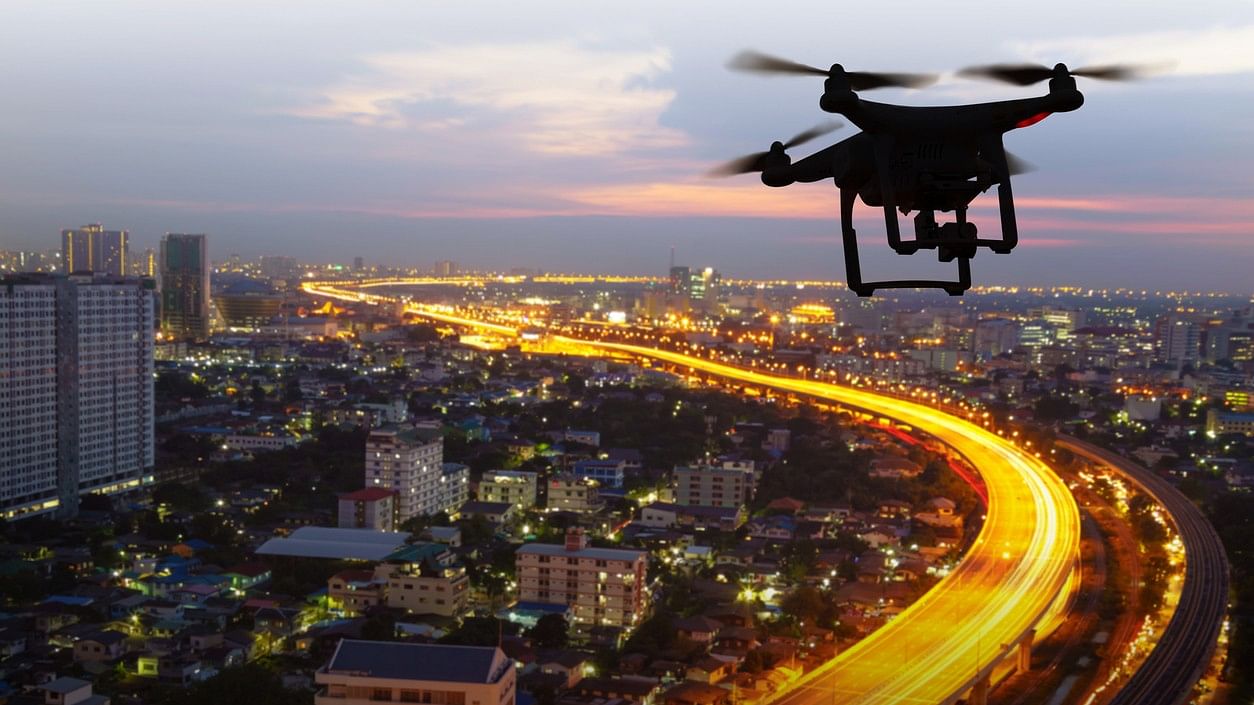
Representative image showing a commercial drone flying over a city.
Credit: iStock Photo
By Smit Shah
Drones have evolved rapidly from military tools to multifaceted instruments shaping various sectors since their initial use in India during the late 1990s Kargil conflict with Pakistan. The successful use of Unmanned Aerial Vehicles (UAVs) in the conflict demonstrated their pivotal role in modern warfare.
The miniaturisation of technologies and availability of open-source flight controllers for multi-copter systems in the global market around 2008 kickstarted many vibrant aeromodelling communities and inspired cinematographers who found a new dimension for capturing breathtaking images and videos through flying cameras. Overtime as the technology matured and the cost for critical components decreased, young entrepreneurs started democratising and commercialising this technology by discovering new applications such as surveying road infrastructure, inspecting industrial chimneys, spraying pesticides in agricultural fields and empowering police departments to conduct surveillance across vast areas. By 2014, a few companies had started pursuing experiments for logistics use cases.
The drone regulatory framework has undergone several amendments and reforms just like any new technology area. After 2014, the emerging domestic drone industry was capitalised on by a few neighbouring countries which developed several low-cost, low-quality drones and components creating supply chain dependency for Indian entrepreneurs and enthusiasts.
Despite many mishappenings in 2020, the global stage bore witness to two remarkable occurrences that were pivotal for drones, both on the international and domestic fronts. While the Nagorno-Karabakh conflict between Armenia and Azerbaijan showcased the full potential of small and large UAVs in defence and homeland security. Closer home, drone companies swiftly rose to the occasion during India's battle with locust swarms. Their adeptness in aerial surveillance, photography, public announcements, and even insecticide spraying in states along the western borders captured the nation's attention, marking a turning point for exploiting many advantages that drones can offer.
With a view of these events, Prime Minister Narendra Modi gave a clarion call to make India a global drone hub by 2030 and the Ministry of Civil Aviation, Government of India under his able guidance brought about several reforms to kickstart and fuel the growth of the Indian drone industry. These included the (a) Ease of doing business vide Drone Rules 2021; (b) Financial Incentives vide Production-Linked Incentive Scheme for drones and their components under which INR 120 crores has been earmarked by the government and the Kisan Drone Subsidy Scheme; (c) Promotion of domestic manufacturing vide Import ban on fully built foreign drones and (d) Promotion of drone export by liberalisation of export policy for civil drones.
Working hand in hand with the Ministry of Civil Aviation and several central and state departments, the Drone Federation of India (DFI) hosted multiple stakeholder meetings among government bodies, regulators, and drone enterprises to promote the widespread adoption of drones. As a result of many such initiatives, drones play a very important role during the construction and progress monitoring of most national highways in India. Drones also play a critical role in enabling transparent and accurate statutory compliances for most mining corporations in India. Such examples can be seen across a variety of sectors underlining a concerted effort towards embracing technological advancement with drones.
Spearheading this shift in the agriculture sector was the Indian cooperative IFFCO, with an announcement in July 2023 to procure 2,500 agricultural drones to promote the use of IFFCO nano fertilisers. Complementing such initiatives, the Central Government launched the Viksit Bharat Sankalp Yatra, connecting farmers with technological advancements during which over 87,000 live demonstrations were conducted showing farmers the use of agriculture drones to spray fertilisers and pesticides in the farmlands. Today, drones are also bringing grassroots women empowerment through the Namo Drone Didi Scheme launched by the Prime Minister to empower 15,000 Women Self Help Groups (SHGs) by providing drones and training them to provide drone spray services to farmers in nearby areas. With DGCA’s intervention, drone training can also be provided in vernacular languages thereby ensuring accessibility and inclusivity for all.
The Indian drone industry is rapidly expanding and is expected to generate over $ 6.6 billion in revenue by 2030, constituting over 7 per cent of the global drone market. Fuelling this growth are 300+ startups operating in various segments like manufacturing, services, software, and skilling. The beneficiaries selected under the government’s PLI scheme have already benefited significantly as their investment and sales grew from INR 82 crores and INR 298 crores in FY 2021-22 to INR 244 crores and INR 319 crores respectively.
The Indian ecosystem already has come a long way since 2021 when the rules were reformed. The total number of registered drones increased from 543 in 2021 to 18,100+ as of today. The total number of type-certified drone models increased from 0 in 2021 to 49 drone models as of today. Over 9200 drone pilots are now certified from 82 drone pilot training schools as opposed to 0 certified drone pilots in 2021.
As technology evolves, the market is evolving with new use cases like long-range border patrol, healthcare delivery, commercial logistics, cross-country pipeline and powerline inspections for which drones must fly higher and further. The density of drones operating in the Indian airspace is also expected to increase significantly which will require advancements in technologies like drone tracking and unmanned traffic management which are crucial for ensuring the safe coexistence of manned and unmanned aircraft in the Indian airspace.
(The author is the President, Drone Federation of India)